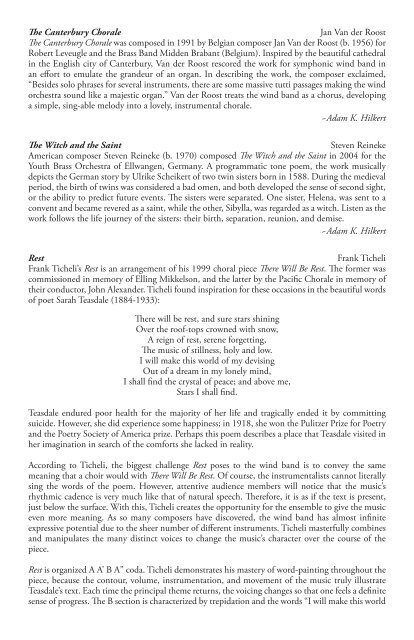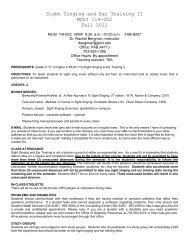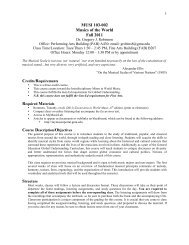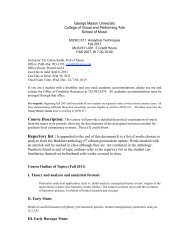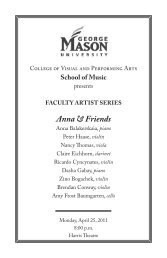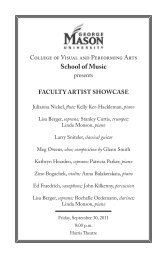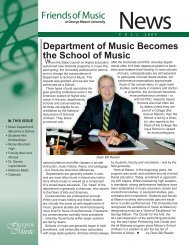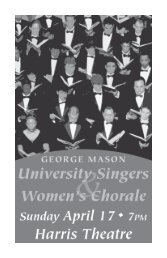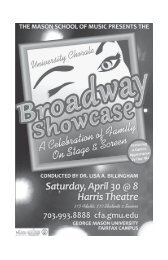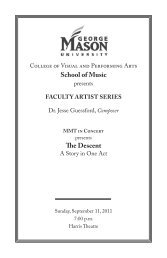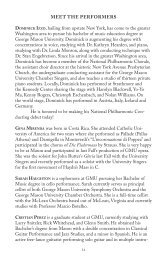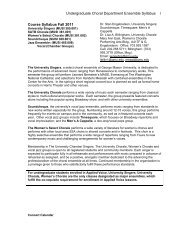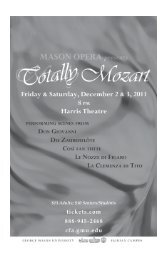Annual Graduate Student Conductors - George Mason University ...
Annual Graduate Student Conductors - George Mason University ...
Annual Graduate Student Conductors - George Mason University ...
Create successful ePaper yourself
Turn your PDF publications into a flip-book with our unique Google optimized e-Paper software.
The Canterbury Chorale Jan Van der Roost<br />
The Canterbury Chorale was composed in 1991 by Belgian composer Jan Van der Roost (b. 1956) for<br />
Robert Leveugle and the Brass Band Midden Brabant (Belgium). Inspired by the beautiful cathedral<br />
in the English city of Canterbury, Van der Roost rescored the work for symphonic wind band in<br />
an effort to emulate the grandeur of an organ. In describing the work, the composer exclaimed,<br />
“Besides solo phrases for several instruments, there are some massive tutti passages making the wind<br />
orchestra sound like a majestic organ.” Van der Roost treats the wind band as a chorus, developing<br />
a simple, sing-able melody into a lovely, instrumental chorale.<br />
~Adam K. Hilkert<br />
The Witch and the Saint Steven Reineke<br />
American composer Steven Reineke (b. 1970) composed The Witch and the Saint in 2004 for the<br />
Youth Brass Orchestra of Ellwangen, Germany. A programmatic tone poem, the work musically<br />
depicts the German story by Ulrike Scheikert of two twin sisters born in 1588. During the medieval<br />
period, the birth of twins was considered a bad omen, and both developed the sense of second sight,<br />
or the ability to predict future events. The sisters were separated. One sister, Helena, was sent to a<br />
convent and became revered as a saint, while the other, Sibylla, was regarded as a witch. Listen as the<br />
work follows the life journey of the sisters: their birth, separation, reunion, and demise.<br />
~Adam K. Hilkert<br />
Rest Frank Ticheli<br />
Frank Ticheli’s Rest is an arrangement of his 1999 choral piece There Will Be Rest. The former was<br />
commissioned in memory of Elling Mikkelson, and the latter by the Pacific Chorale in memory of<br />
their conductor, John Alexander. Ticheli found inspiration for these occasions in the beautiful words<br />
of poet Sarah Teasdale (1884-1933):<br />
There will be rest, and sure stars shining<br />
Over the roof-tops crowned with snow,<br />
A reign of rest, serene forgetting,<br />
The music of stillness, holy and low.<br />
I will make this world of my devising<br />
Out of a dream in my lonely mind,<br />
I shall find the crystal of peace; and above me,<br />
Stars I shall find.<br />
Teasdale endured poor health for the majority of her life and tragically ended it by committing<br />
suicide. However, she did experience some happiness; in 1918, she won the Pulitzer Prize for Poetry<br />
and the Poetry Society of America prize. Perhaps this poem describes a place that Teasdale visited in<br />
her imagination in search of the comforts she lacked in reality.<br />
According to Ticheli, the biggest challenge Rest poses to the wind band is to convey the same<br />
meaning that a choir would with There Will Be Rest. Of course, the instrumentalists cannot literally<br />
sing the words of the poem. However, attentive audience members will notice that the music’s<br />
rhythmic cadence is very much like that of natural speech. Therefore, it is as if the text is present,<br />
just below the surface. With this, Ticheli creates the opportunity for the ensemble to give the music<br />
even more meaning. As so many composers have discovered, the wind band has almost infinite<br />
expressive potential due to the sheer number of different instruments. Ticheli masterfully combines<br />
and manipulates the many distinct voices to change the music’s character over the course of the<br />
piece.<br />
Rest is organized A A’ B A” coda. Ticheli demonstrates his mastery of word-painting throughout the<br />
piece, because the contour, volume, instrumentation, and movement of the music truly illustrate<br />
Teasdale’s text. Each time the principal theme returns, the voicing changes so that one feels a definite<br />
sense of progress. The B section is characterized by trepidation and the words “I will make this world


